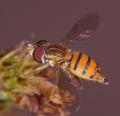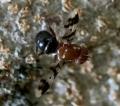Diptera.info :: Identification queries :: Diptera (adults)
Who is here? 1 guest(s)
|
Tachinidae (?) from Panama
|
|
| Dmitry Gavryushin |
Posted on 05-09-2006 07:54
|
|
Member Location: Moscow region, Russia Posts: 3319 Joined: 17.10.05 |
This picture was taken by a friend of mine in Panama, Chiriqui, Cerro Punta. Size 17mm. Any suggestions are welcome...
Dmitry Gavryushin attached the following image:  [101.6Kb] |
|
|
|
| Robert Nash |
Posted on 05-09-2006 08:50
|
|
Member Location: Ulster Museum, Belfast, Ireland Posts: 288 Joined: 11.11.05 |
A very quick browse through the plates in Wulp's second volume of Biologia Centrali-Americana which may be seen free at http://www.sil.si.edu/digitalcollections/bca/explore.cfm See Diptera.info Weblinks > Resources produced no result (yet) but your freind may be interested in this excellent    resource. Robert resource. Robert
Edited by Robert Nash on 05-09-2006 08:52 |
| Dmitry Gavryushin |
Posted on 05-09-2006 09:06
|
|
Member Location: Moscow region, Russia Posts: 3319 Joined: 17.10.05 |
Thanks Robert - actually, checking the plates of Biologia Centrali-Americana was the first thing i did  ... ... |
|
|
|
| ChrisR |
Posted on 05-09-2006 10:08
|
|
Super Administrator Location: Reading, England Posts: 7703 Joined: 12.07.04 |
I've no idea what it is ... but I want one!!  |
| Dmitry Gavryushin |
Posted on 05-09-2006 11:00
|
|
Member Location: Moscow region, Russia Posts: 3319 Joined: 17.10.05 |
So do I  ... ... |
|
|
|
| crex |
Posted on 05-09-2006 11:13
|
|
Member Location: Sweden Posts: 1996 Joined: 22.05.06 |
Is it Tachinidae or Bombyliidae? The small head, broad abdomen and leather like wings make it (in my newbie eyes) look a bit like a bee fly. I'm not sure Bombyliidae has tha large "feet" though ... I have yet to learn how to interpret what the wing venetaion tells. |
|
|
|
| crex |
Posted on 05-09-2006 11:30
|
|
Member Location: Sweden Posts: 1996 Joined: 22.05.06 |
Perhaps a compromise, something like Hystricia (=Bombyliopsis) [Tachinidae] ... Ok, I'll stop guessing now  |
|
|
|
| ChrisR |
Posted on 05-09-2006 12:49
|
|
Super Administrator Location: Reading, England Posts: 7703 Joined: 12.07.04 |
The wing venation is the key here really. The fly pictured is clearly a calyptrate - wing veins radiate to the edge of the wing with little or no sinuosity and no forks beyond the proximal 1/2. There is a strong bend in vein M and this suggests Tachinidae or Sarcophagidae - my guess, based on the bristles and general 'look' of the fly would be Tachinidae. Bombylidae have many more forked veins on their wings, similar to other larger Brachycera, such as Tabanidae. In general, Brachycera wings seem to have many more veins.  |
| Zeegers |
Posted on 05-09-2006 19:52
|
|
Member Location: Soest, NL Posts: 18921 Joined: 21.07.04 |
I agree This is 100 % a Calyptratae and actually I have no doubt whatsoever that this is a Tachinid (even though I am completely non-expert where the new world is concerned) Theo |
|
|
|
| Dmitry Gavryushin |
Posted on 05-09-2006 20:06
|
|
Member Location: Moscow region, Russia Posts: 3319 Joined: 17.10.05 |
Thanks to all for your attention  . . |
|
|
|
| Dmitry Gavryushin |
Posted on 27-12-2006 19:29
|
|
Member Location: Moscow region, Russia Posts: 3319 Joined: 17.10.05 |
Hello everybody, I have finally received a reply from Dr. D. Monty Wood, so now we can put a generic name on it: a Scotiptera sp. (Tachinidae). Here's an excerpt from the message: ...this is probably the first record for Panama. I see after reading your letter again that it is from Cerro Punta. I have caught several of them in Costa Rica in the Talamanca Mtns sitting on leaves alongside the stream in the sun spots. Unfortunately the species doesn't yet have a name. There are about 10 species of Scotiptera in Costa Rica in the INBio collection (do you know about this?), but this is the only one with orange wing bases. Happy New Year to all! Edited by Dmitry Gavryushin on 27-12-2006 19:29 |
|
|
|
| Jump to Forum: |













